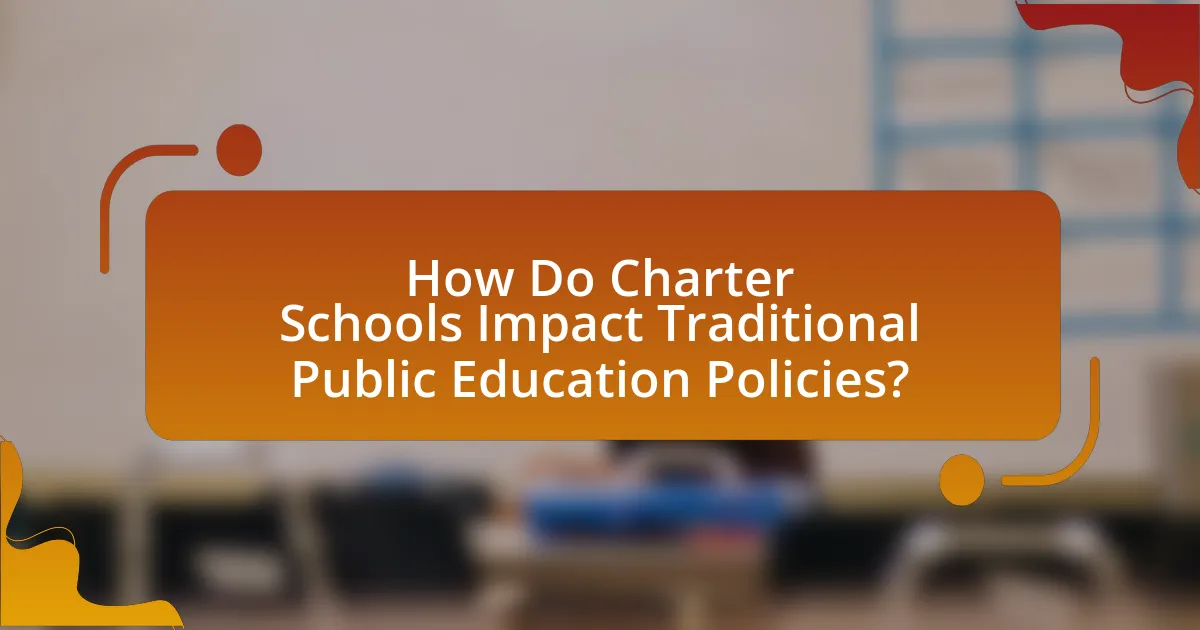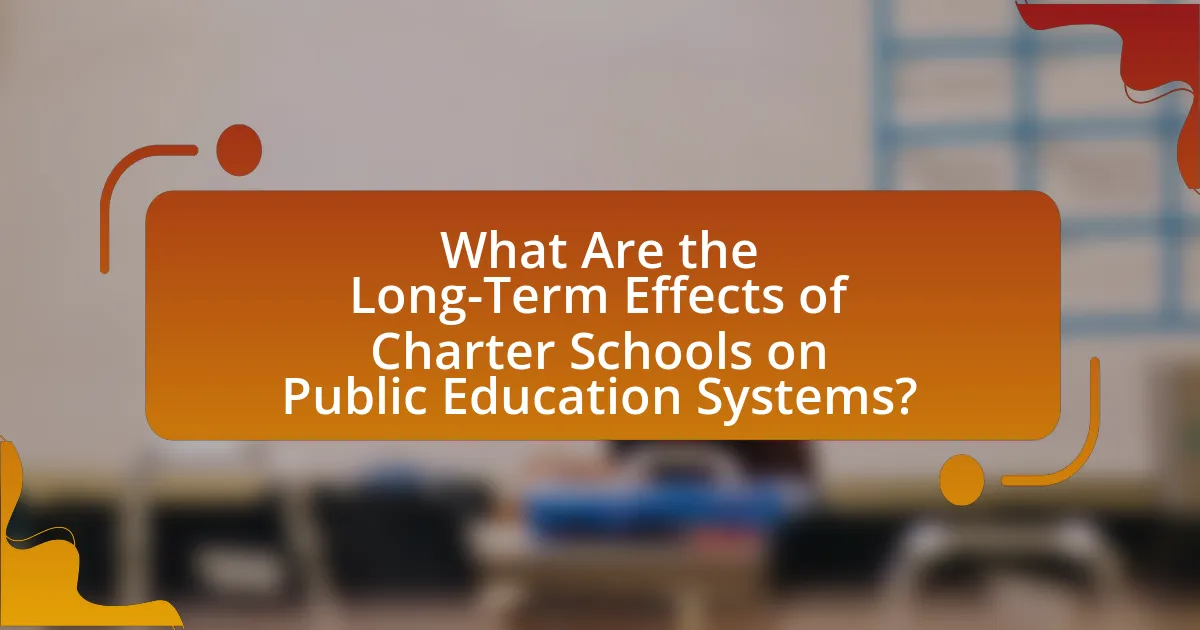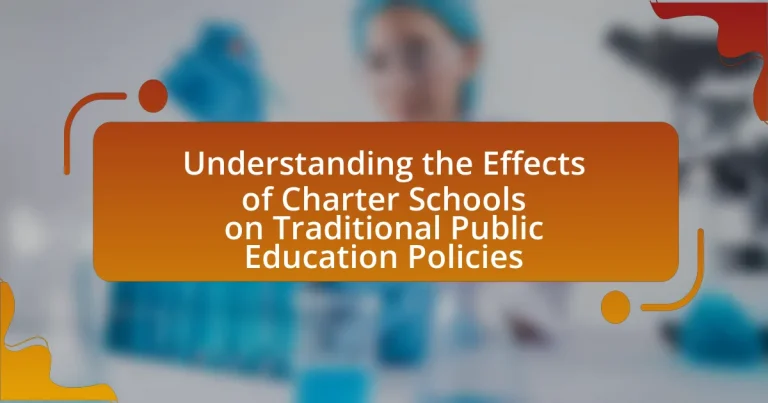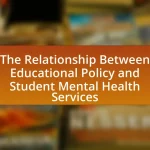Charter schools are publicly funded educational institutions that operate independently from traditional public school systems, established through a performance contract known as a charter. This article examines the operational autonomy of charter schools, their funding mechanisms, governance structures, and their primary goals of innovation and improved student achievement. It also explores the impact of charter schools on traditional public education policies, including funding allocations, accountability measures, and demographic shifts in student populations. Additionally, the article discusses the ongoing debates surrounding charter schools, highlighting both the support and opposition they face from various stakeholders, as well as the long-term effects they have on public education systems.

What are Charter Schools and How Do They Operate?
Charter schools are publicly funded educational institutions that operate independently of the traditional public school system. They are established through a charter, which is a performance contract detailing the school’s mission, program, students served, and methods of assessment. Charter schools have the flexibility to design their own curricula and educational approaches, which allows them to innovate and cater to specific student needs.
In the United States, as of 2021, there were over 7,500 charter schools serving approximately 3.3 million students, demonstrating their significant role in the education landscape. These schools are held accountable for academic results and must meet the performance standards outlined in their charters to remain operational. If they fail to meet these standards, they can be closed by the authorizing body, which is typically a state or local education agency. This accountability mechanism is a key aspect of how charter schools operate, distinguishing them from traditional public schools.
What distinguishes charter schools from traditional public schools?
Charter schools are distinguished from traditional public schools primarily by their operational autonomy and accountability. Unlike traditional public schools, which are governed by school districts and must adhere to specific regulations and curricula set by state education departments, charter schools operate under a charter that grants them greater flexibility in their educational approaches, staffing, and budget management. This autonomy allows charter schools to innovate and implement unique educational models, which can lead to varied academic outcomes. According to the National Center for Education Statistics, as of 2020, there were over 7,500 charter schools in the United States, serving more than 3 million students, highlighting their significant presence in the educational landscape.
How are charter schools funded compared to traditional public schools?
Charter schools are funded primarily through public funding based on student enrollment, similar to traditional public schools, but they often receive less funding per student. Traditional public schools typically receive funding from local property taxes, state funding, and federal grants, which can create disparities in funding levels based on geographic location. In contrast, charter schools may also seek additional funding through private donations and grants, which can further differentiate their financial resources. According to the National Center for Education Statistics, charter schools generally receive about 70-80% of the funding that traditional public schools receive per pupil, leading to potential challenges in resource allocation and educational outcomes.
What governance structures do charter schools typically have?
Charter schools typically have a governance structure that includes a board of directors or trustees responsible for overseeing the school’s operations and ensuring compliance with its charter. This board is often composed of community members, educators, and parents, providing a diverse perspective on school management. The governance model allows for autonomy in decision-making while holding the school accountable for academic performance and financial management, as mandated by state laws. For instance, according to the National Alliance for Public Charter Schools, over 90% of charter schools operate under a nonprofit organization, which reinforces their commitment to public education and accountability.
What are the primary goals of charter schools?
The primary goals of charter schools are to provide innovative educational options, improve student achievement, and increase parental choice in education. Charter schools aim to enhance educational outcomes by implementing unique curricula and teaching methods that may not be available in traditional public schools. Research indicates that charter schools often focus on accountability and performance, as they operate under a charter that outlines specific educational objectives and outcomes. For instance, studies have shown that some charter schools demonstrate higher student performance in standardized tests compared to their traditional counterparts, highlighting their effectiveness in achieving educational goals.
How do charter schools aim to improve educational outcomes?
Charter schools aim to improve educational outcomes by implementing innovative teaching methods and curricula tailored to meet the needs of their students. These schools operate with greater autonomy than traditional public schools, allowing them to adopt specialized programs that can enhance student engagement and achievement. Research indicates that charter schools often focus on accountability measures, such as performance-based assessments, which incentivize higher academic standards. For instance, a study by the National Bureau of Economic Research found that students in charter schools in certain urban areas demonstrated higher test scores compared to their peers in traditional public schools, highlighting the effectiveness of charter school strategies in improving educational outcomes.
What role do innovation and flexibility play in charter school operations?
Innovation and flexibility are crucial in charter school operations as they enable schools to tailor educational approaches to meet diverse student needs. Charter schools often implement unique curricula, teaching methods, and assessment strategies that differ from traditional public schools, allowing for experimentation and adaptation based on student performance and community feedback. For instance, a study by the National Center for Education Statistics found that charter schools are more likely to adopt innovative practices, such as project-based learning and technology integration, which can lead to improved student engagement and outcomes. This adaptability helps charter schools respond quickly to changing educational demands and fosters an environment conducive to continuous improvement.

How Do Charter Schools Impact Traditional Public Education Policies?
Charter schools impact traditional public education policies by introducing competition and innovation, which can lead to reforms in curriculum, funding, and governance. Research indicates that the presence of charter schools often prompts traditional public schools to adopt new teaching methods and improve their performance to retain students. For instance, a study by the National Bureau of Economic Research found that districts with a higher concentration of charter schools experienced improvements in student achievement, particularly in urban areas. Additionally, charter schools frequently advocate for policy changes that promote school choice and accountability, influencing legislative discussions and funding allocations in the public education system.
What changes in policy have emerged due to the presence of charter schools?
The presence of charter schools has led to significant changes in education policy, particularly in areas such as funding, accountability, and school choice. Policymakers have increasingly shifted funding models to allocate resources based on student enrollment rather than school type, which has resulted in a more competitive environment among schools. Additionally, charter schools have prompted the establishment of stricter accountability measures, requiring both charter and traditional public schools to meet performance benchmarks. This shift has been supported by research indicating that charter schools often operate with greater flexibility and innovation, which has influenced traditional public school policies to adopt similar practices in order to remain competitive.
How have accountability measures evolved in response to charter schools?
Accountability measures have evolved significantly in response to the establishment and growth of charter schools, primarily through the implementation of performance-based evaluations and increased oversight. Initially, charter schools operated with greater autonomy and less stringent accountability compared to traditional public schools; however, as their numbers increased, states began to adopt more rigorous accountability frameworks. For instance, many states now require charter schools to meet specific academic performance metrics, financial audits, and compliance with state educational standards to maintain their charters. Research from the National Alliance for Public Charter Schools indicates that over 40 states have enacted laws mandating performance evaluations for charter schools, reflecting a shift towards ensuring educational quality and fiscal responsibility. This evolution demonstrates a growing recognition of the need for accountability in the charter school sector to safeguard student outcomes and public investment.
What influence do charter schools have on funding allocations for traditional public schools?
Charter schools influence funding allocations for traditional public schools by diverting a portion of public education funding away from them. When students enroll in charter schools, the funding that would have been allocated to their local public school is often redirected to the charter institution, which can lead to reduced financial resources for traditional public schools. For instance, a study by the National Center for Education Statistics found that in states with a high number of charter schools, traditional public schools experienced significant funding decreases, impacting their ability to maintain programs and staff. This financial shift can exacerbate inequalities in educational resources and outcomes between charter and traditional public schools.
Why do some stakeholders support charter schools while others oppose them?
Some stakeholders support charter schools because they believe these institutions promote educational innovation and provide parents with more choices, while others oppose them due to concerns about funding, accountability, and potential negative impacts on traditional public schools. Proponents argue that charter schools can operate with greater flexibility and autonomy, allowing for tailored educational approaches that can lead to improved student outcomes. For instance, a study by the National Center for Education Statistics found that charter schools often have higher student achievement in certain contexts. Conversely, opponents highlight that charter schools can divert funding from public schools, leading to resource shortages and inequities. Research from the Center for American Progress indicates that the expansion of charter schools can exacerbate segregation and diminish the quality of education in traditional public schools.
What arguments do proponents of charter schools make regarding educational choice?
Proponents of charter schools argue that educational choice enhances competition, leading to improved educational outcomes. They assert that charter schools provide parents with alternatives to traditional public schools, fostering an environment where schools must innovate and perform to attract students. Research indicates that in many cases, charter schools demonstrate higher student achievement compared to their traditional counterparts, particularly in urban areas. For instance, a study by the Center for Research on Education Outcomes (CREDO) at Stanford University found that students in charter schools gained more learning in reading and math than those in traditional public schools. This evidence supports the claim that educational choice through charter schools can lead to better academic performance and greater satisfaction among families.
What concerns do critics raise about the impact of charter schools on public education?
Critics raise concerns that charter schools can undermine traditional public education by diverting funding and resources away from public schools. This financial impact can lead to budget cuts in public schools, resulting in larger class sizes and reduced educational services. Additionally, critics argue that charter schools may exacerbate segregation by attracting students from specific demographics, thereby limiting diversity in public schools. Research from the National Education Association indicates that charter schools often do not serve the same proportion of students with disabilities or English language learners as traditional public schools, raising equity concerns.

What Are the Long-Term Effects of Charter Schools on Public Education Systems?
Charter schools have significant long-term effects on public education systems, primarily influencing funding, student demographics, and educational outcomes. Research indicates that the presence of charter schools often leads to a reallocation of public funding, as funds are diverted from traditional public schools to support charter operations. For instance, a study by the National Bureau of Economic Research found that in areas with a high concentration of charter schools, traditional public schools experienced budget cuts, which can negatively impact resources and educational quality.
Additionally, charter schools tend to attract a different demographic of students, often leading to increased segregation by socioeconomic status and race. A report from the Stanford Center for Opportunity Policy in Education highlighted that charter schools frequently enroll fewer students with disabilities and English language learners compared to traditional public schools, which can exacerbate inequities in the education system.
Moreover, the academic outcomes of charter schools vary widely, with some studies showing that charter schools can outperform traditional public schools in certain contexts, while others indicate no significant difference or even worse performance. The CREDO study from Stanford University revealed that, on average, students in charter schools gain more ground in reading but less in math compared to their peers in traditional public schools.
Overall, the long-term effects of charter schools on public education systems include financial strain on traditional schools, demographic shifts that may increase inequality, and mixed academic outcomes, all of which contribute to ongoing debates about the role of charter schools in the broader educational landscape.
How do charter schools affect student demographics in traditional public schools?
Charter schools influence student demographics in traditional public schools by attracting a diverse range of students, often leading to demographic shifts in the latter. Research indicates that when charter schools open, they frequently draw students from various backgrounds, including those from lower-income families and minority groups, which can result in a decrease in enrollment in traditional public schools. For instance, a study by the National Center for Education Statistics found that in areas with a high concentration of charter schools, traditional public schools experienced a decline in enrollment by approximately 5% to 10%, particularly among minority students. This shift can alter the racial and socioeconomic composition of the student body in traditional public schools, impacting resource allocation and educational strategies.
What trends have been observed in student enrollment patterns?
Recent trends in student enrollment patterns indicate a significant increase in charter school enrollment, which has been accompanied by a decline in traditional public school enrollment. Data from the National Center for Education Statistics shows that between 2000 and 2020, charter school enrollment grew from approximately 1 million to over 3.4 million students, reflecting a shift in parental preference towards alternative education options. This trend is particularly pronounced in urban areas, where families seek more diverse educational opportunities. Additionally, the COVID-19 pandemic accelerated this trend, as many families opted for remote learning options provided by charter schools, further impacting traditional public school enrollment figures.
How do charter schools influence the diversity of educational offerings?
Charter schools influence the diversity of educational offerings by providing alternative curricula and teaching methods that differ from traditional public schools. These schools often focus on specialized programs, such as STEM, arts, or language immersion, which cater to diverse student interests and needs. For instance, a study by the National Center for Education Statistics found that charter schools are more likely to implement innovative educational practices, thereby expanding the range of options available to families. This diversification can lead to increased competition among schools, prompting traditional public schools to adapt and enhance their own offerings to retain students.
What lessons can be learned from the charter school movement for future education policy?
The charter school movement teaches that flexibility in governance and curriculum can lead to innovative educational practices. This flexibility allows schools to tailor their approaches to meet diverse student needs, as evidenced by studies showing that charter schools often outperform traditional public schools in urban areas. For instance, a 2015 study by the Center for Research on Education Outcomes found that students in charter schools in 27 states gained more learning in reading and math compared to their peers in traditional schools. Additionally, the movement highlights the importance of accountability; charter schools are held to performance standards that can inform future education policy by emphasizing outcomes over inputs. This focus on measurable results can guide policymakers in creating frameworks that prioritize student achievement and effective resource allocation.
How can traditional public schools adapt to the challenges posed by charter schools?
Traditional public schools can adapt to the challenges posed by charter schools by enhancing their educational offerings and improving community engagement. By implementing innovative teaching methods and curricula that cater to diverse student needs, traditional public schools can attract and retain students who might otherwise choose charter options. For instance, incorporating project-based learning and technology integration has been shown to increase student engagement and achievement, as evidenced by studies indicating that schools adopting these practices see improved test scores and graduation rates. Additionally, fostering strong relationships with parents and the community through regular communication and involvement initiatives can help build trust and support for traditional public schools, making them a more appealing choice for families.
What best practices can be implemented to enhance collaboration between charter and traditional schools?
To enhance collaboration between charter and traditional schools, establishing formal partnerships and shared initiatives is essential. These partnerships can include joint professional development programs, where educators from both types of schools collaborate on curriculum development and teaching strategies, fostering a culture of shared learning. Research indicates that collaborative efforts can lead to improved educational outcomes, as seen in studies like the one conducted by the National Center for Education Statistics, which found that schools engaging in collaborative practices often report higher student achievement levels. Additionally, creating platforms for regular communication, such as joint committees or forums, allows for the exchange of best practices and resources, further strengthening the relationship between charter and traditional schools.
What strategies can stakeholders employ to navigate the effects of charter schools on public education?
Stakeholders can employ several strategies to navigate the effects of charter schools on public education, including collaboration, advocacy for equitable funding, and data-driven decision-making. Collaboration among traditional public schools, charter schools, and community organizations can foster resource sharing and best practices, enhancing educational outcomes for all students. Advocacy for equitable funding ensures that public resources are allocated fairly, addressing disparities that may arise from the presence of charter schools. Data-driven decision-making involves analyzing performance metrics and student outcomes to inform policies and practices, allowing stakeholders to adapt and respond effectively to the evolving educational landscape. These strategies are supported by research indicating that collaboration and equitable funding can lead to improved educational equity and student success.


